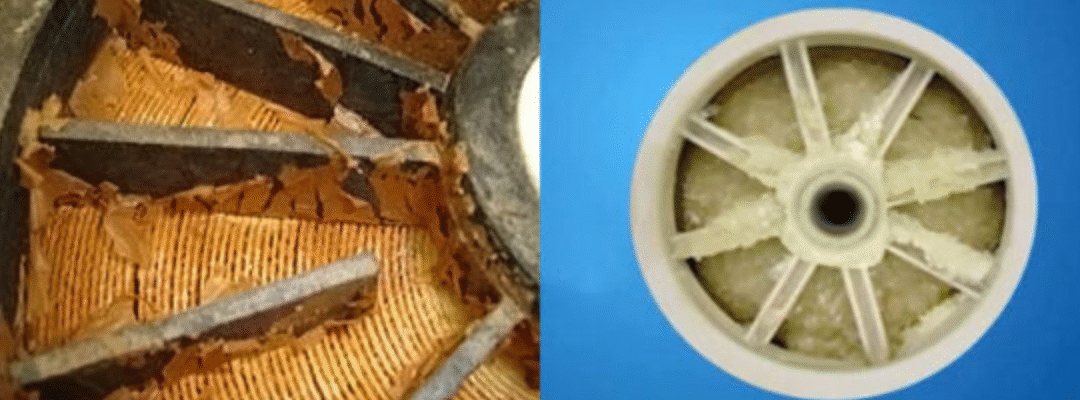In every Reverse Osmosis (RO) water treatment system, the membrane is the heart of the operation — responsible for removing dissolved salts, metals, and impurities.
However, RO membranes gradually lose efficiency due to fouling, a common issue involving the accumulation of unwanted material on the membrane surface.
Membrane fouling leads to:
- Lower permeate (product water) flow
- Higher energy and chemical use
- Pressure imbalance
- Early membrane degradation
In this article, we’ll cover the main causes of fouling, field-tested prevention techniques, and effective cleaning methods to keep your system running at peak performance.
1. What Is Membrane Fouling?
Membrane fouling occurs when suspended solids, colloids, microorganisms, or chemical precipitates deposit on or within RO membrane pores.
These deposits restrict water flow, increase feed pressure, and reduce membrane permeability.
Key Signs of Membrane Fouling:
- Declining product water output (10–50%)
- Gradual increase in feed and differential pressure
- Rising TDS or drop in salt rejection
- Higher power and chemical usage than baseline
Tip from the field: Track differential pressure weekly. An increase >15% often signals early fouling.
2. Types and Causes of Membrane Fouling
| Type of Fouling | Main Cause | Effect / Symptoms |
|---|---|---|
| Particulate Fouling | Silt, sand, rust, colloids | Flow reduction, pressure increase |
| Organic Fouling | Natural organics, oils, industrial waste | Sticky biofilm, odor, TDS fluctuation |
| Biological Fouling | Bacterial/algal growth | Slimy layer, odor, microbial contamination |
| Scaling | Calcium, silica, sulfates | Crystalline deposits, pressure imbalance |
| Chemical Fouling | Chlorine, oxidants, metals | Membrane damage, discoloration, cracking |
a) Particulate / Colloidal Fouling
Caused by sand, clay, or rust from inadequate filtration.
Measured using SDI (Silt Density Index) — should remain below 5.
b) Organic Fouling
Sticky organic matter (humic acids, oils) forms a base for microbial growth.
Often found in surface water and wastewater reuse systems.
c) Biological Fouling
Occurs when bacteria or algae multiply and form a biofilm.
Linked to poor sanitization, low chlorine neutralization, or system stagnation.
d) Scaling (Inorganic Fouling)
Triggered by hardness salts (CaCO₃, BaSO₄, SiO₂).
Happens when pH rises or antiscalant dosing is incorrect.
e) Chemical Fouling
Caused by oxidants like chlorine or high iron.
Can permanently damage the polyamide layer of RO membranes.
3. Effects of Membrane Fouling
- Reduced permeate flow → productivity loss
- Higher energy use → increased operating cost
- TDS rises → reduced water quality
- More frequent cleaning → shorter membrane lifespan
- More downtime → higher labor and maintenance costs
4. Prevention of Membrane Fouling
a) Effective Pre-Treatment
Install:
- Multi-media filters (MMF) to remove turbidity
- Micron cartridge filters (5 µm) before RO
- Activated carbon filters (ACF) to neutralize chlorine
Goal: SDI < 5, turbidity < 1 NTU
b) Antiscalant Dosing
Use dosing systems for scaling control:
- Calibrate pumps weekly
- Choose a branded antiscalant compatible with your feedwater profile
c) pH & Oxidant Control
- Maintain pH: 6.5–7.0
- Remove chlorine using sodium metabisulfite (SMBS) before RO
d) Routine Flushing
- Auto-flush membranes after every shutdown
- Prevent sediment build-up during idle periods
e) Disinfection and UV
- Use UV sterilizers or non-oxidizing biocides
- Clean storage tanks every 3–4 months
Bonus Tip: Add inline turbidity and pH sensors to enable real-time alerts.
5. Cleaning Methods for Fouled Membranes
Each fouling type requires a different approach:
| Fouling Type | Cleaning Method | Chemicals Used |
|---|---|---|
| Scaling | Acid cleaning | Citric acid, dilute HCl (pH 2–3) |
| Organic Fouling | Alkaline cleaning | NaOH, alkaline surfactants (pH 10) |
| Biofouling | Sanitization | H₂O₂, non-oxidizing biocides |
| Particulates | Rinse + mild detergent | Neutral pH cleaner |
| Iron Fouling | Acid + Chelating Agent | EDTA, oxalic acid |
Standard CIP Process:
- Isolate the RO and prepare the CIP tank
- Circulate solution at low pressure (no back pressure)
- Soak for 30–60 minutes
- Rinse with RO permeate or DI water
- Resume operation and monitor pressure, TDS, and flow
Always clean in correct order: alkaline → rinse → acid → rinse
6. Monitoring and Early Detection
Install sensors or log manually for these indicators:
- Differential pressure across membrane
- Permeate flow rate trends
- Salt rejection efficiency (% change over time)
- SDI, turbidity, pH of feedwater
Use SCADA or a simple Excel sheet to detect early deviations.
7. Best Practices to Extend Membrane Life
- Replace filters every 3–6 months
- Perform CIP based on performance data, not calendar dates
- Flush membranes after idle periods >6 hrs
- Avoid storing membranes dry or in sunlight
- Log TDS, pressure, and flow daily
- Train operators in cleaning sequence and chemical safety
Summary Table – Causes, Prevention & Cleaning
| Cause | Prevention Methods | Cleaning Solution |
|---|---|---|
| Suspended solids | MMF + Cartridge filter (5 µm) | Physical rinse, detergent |
| Organic matter | Carbon filter, UV, regular flushing | Alkaline CIP |
| Scaling | Antiscalant dosing, pH control | Acid CIP |
| Biofouling | Biocide dosing, UV, flushing | H₂O₂, non-oxidizing biocide |
| Iron/Ferric | Oxidation + filtration | EDTA + acid cleaning |
Frequently Asked Questions (FAQs)
Q1. What is the most common cause of membrane fouling?
Suspended solids and scaling due to poor pre-treatment or chemical imbalance.
Q2. How often should membranes be cleaned?
Every 3–6 months, or when pressure drop exceeds 15%.
Q3. Can chlorine damage the RO membrane?
Yes — even low levels can oxidize the membrane’s polyamide layer.
Q4. How can I prevent biofouling?
Use UV or biocide dosing and avoid system stagnation.
Q5. What is the average lifespan of an RO membrane?
3 to 5 years, depending on water quality and preventive care.


Recent Comments